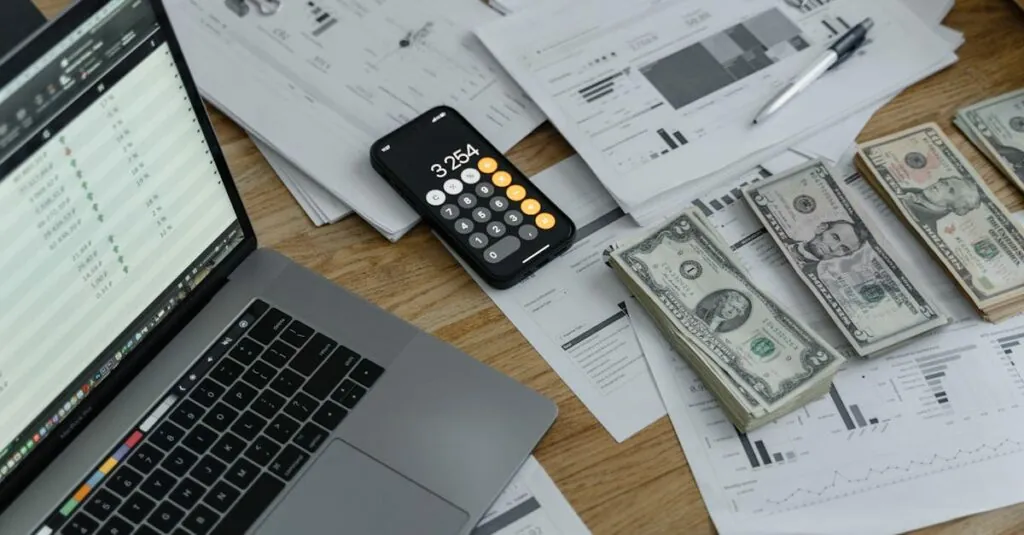Table of Contents
ToggleIn a world where carrying cash feels as outdated as dial-up internet, mobile payment apps have swooped in like superheroes armed with convenience. They’ve transformed the way people handle transactions, making it easier than ever to pay for that morning coffee or split the bill with friends. Who needs a wallet when your smartphone can do all the heavy lifting?
Overview of Mobile Payment Apps
Mobile payment apps streamline transactions and cater to modern consumer needs. These applications allow users to make payments using smartphones, ensuring quick and secure transactions. Popular mobile payment apps include PayPal, Venmo, and Apple Pay, each offering unique features.
Various functionalities enhance user experience. For instance, users can link bank accounts, credit cards, or debit cards for seamless transfers. Many apps provide instant notifications, helping users track spending in real-time. Security also plays a crucial role; encryption and biometric authentication methods protect sensitive data.
Mobile payment adoption has surged significantly. Statista reports that in 2023, 53% of U.S. adults utilize mobile payment apps, reflecting changing consumer preferences. Increased smartphone penetration and growing trust in digital transactions drive this growth.
Businesses benefit from adopting mobile payment solutions. They can improve customer engagement, enhance transaction speed, and reduce cash handling. Customers appreciate convenience, making mobile payment apps a valuable tool for merchants.
Consumer demographics reveal diverse user bases. Young adults, particularly those aged 18 to 34, dominate mobile payment usage. However, adoption is rising among older populations as familiarity with technology increases.
Overall, mobile payment apps continually evolve. Features like loyalty rewards and integration with e-commerce platforms are becoming standard. This evolution positions them as essential tools in the financial landscape, supporting both everyday purchases and larger transactions.
Key Features of Mobile Payment Apps
Mobile payment apps offer several features that enhance user experience and transaction efficiency. Understanding these key features can help users select the right app for their financial needs.
User Interface and Experience
An intuitive user interface simplifies navigation within mobile payment apps. Clarity in design allows users to complete transactions quickly. Customizable settings cater to individual preferences, ensuring a personalized experience. Accessibility options accommodate various needs, enabling broader usability. Overall, the seamless interaction fosters user satisfaction and encourages frequent use.
Security Measures
Mobile payment apps prioritize security to protect sensitive information. Encryption safeguards data during transactions, providing a secure environment for users. Biometric authentication adds another layer of protection, ensuring that only authorized users can access their accounts. Regular security updates help manage potential vulnerabilities. Users can confidently make payments, knowing their information remains secure.
Transaction Speed
Transaction speed plays a crucial role in user satisfaction. Most mobile payment apps facilitate instant payments, allowing users to send or receive money quickly. Quick processing times reduce waiting periods, enhancing the overall transaction experience. Users also benefit from real-time notifications that confirm completed payments, promoting transparency. Enhanced speed supports frequent use in day-to-day transactions.
Popular Mobile Payment Apps
Numerous mobile payment apps dominate the market today. Each app offers distinct features that cater to varied consumer needs.
Venmo
Venmo stands out for its social payment features. Users can send money to friends while sharing payment notes, enhancing social engagement. Instant transfers make it convenient for splitting bills or sharing expenses. Venmo’s integration with businesses also enables users to pay at select retailers. As of 2023, it reports over 80 million users in the U.S., demonstrating its popularity among younger demographics.
PayPal
PayPal remains a leading mobile payment option globally. The app supports a wide range of transactions, including e-commerce purchases and international transfers. Users appreciate its buyer protection policies that safeguard against fraud. PayPal’s extensive merchant partnerships ensure seamless payments at various online and physical stores. Currently, PayPal serves over 400 million active accounts, highlighting its widespread trust and adoption.
Cash App
Cash App, developed by Square, appeals to younger users who prefer its straightforward interface. It allows instant peer-to-peer payments and offers features like Cash Card, enabling users to spend their balance anywhere. Users can also invest in stocks and Bitcoin directly through the app. Its user base has surpassed 40 million, reflecting its growing influence in the mobile payment space.
Apple Pay
Apple Pay boasts integration with Apple devices, making transactions convenient for users. It enables secure payments via iPhones and Apple Watches, employing facial recognition or fingerprint authentication. Businesses benefit from its contactless payment processing, providing an efficient checkout experience. As of 2023, Apple Pay claims over 500 million users globally, showcasing its solid market presence.
Google Pay
Google Pay combines mobile payments with personalized offers and loyalty rewards. Users can make secure transactions at stores or online, syncing their payment information easily across devices. The app also emphasizes security with multiple layers of encryption. Google Pay has attracted millions of users worldwide, marking its rise as a significant player in the mobile payment ecosystem.
Benefits of Using Mobile Payment Apps
Mobile payment apps offer numerous advantages, enhancing the way consumers manage financial transactions.
Convenience and Accessibility
Convenience defines mobile payment apps. Users access these platforms directly from their smartphones, making payments effortless. Instant transactions eliminate lengthy checkout lines and cumbersome card swiping. Most apps allow users to link multiple payment methods, ensuring flexibility. Transactions occur anytime and anywhere, so users no longer carry cash. Notifications inform users of payment confirmations, enhancing peace of mind. Additionally, apps designed with user-friendly interfaces cater to a wide demographic. Such accessibility encourages adoption among varied age groups, from tech-savvy youth to older users seeking straightforward solutions.
Cost-Effectiveness
Cost-effectiveness emerges as a key benefit of mobile payment apps. Many apps charge minimal or no fees for peer-to-peer transactions, allowing users to save money. Merchants often experience reduced transaction fees compared to traditional credit card processing methods. These savings foster increased acceptance among businesses, contributing to greater convenience for the consumer. Some apps also feature loyalty programs that reward users with cashback or discounts, which enhances overall value. Users enjoy financial control through straightforward spending tracking, helping avoid unnecessary charges. As digital transactions rise, the cost-effectiveness of these apps solidifies their presence in modern payments.
Challenges with Mobile Payment Apps
Mobile payment apps face several challenges that can impact user adoption and experience.
Security Concerns
Security concerns rank high among potential barriers to wider adoption. Users worry about data breaches and unauthorized access to financial information. Encryption and biometric authentication provide essential protection, yet persistent vulnerabilities exist. In 2023, 53% of U.S. adults consider security a primary factor regarding mobile payments. The fear of fraud can hinder new users from embracing these technologies. Transparent communication about security measures can help mitigate these fears.
Technology Barriers
Technology barriers often limit the reach of mobile payment apps. Many individuals, especially older adults, may struggle with smartphone technology. Compatibility issues with older devices can prevent app downloads or usage. Additionally, some users might lack reliable internet access, further complicating mobile transactions. User-friendly interfaces remain critical for broader acceptance. Supporting educational initiatives can bridge the technology gap, facilitating adoption among all demographics.
Mobile payment apps have revolutionized the way people conduct transactions in today’s fast-paced world. Their convenience and efficiency cater to the needs of modern consumers while enhancing security features build trust in digital payments. As adoption continues to rise across various demographics, the potential for these apps to further integrate into daily life remains promising.
The ongoing evolution of mobile payment technology, including loyalty rewards and e-commerce integration, positions these apps as essential tools for both consumers and businesses. While challenges like security concerns and technology barriers persist, the benefits of mobile payment apps are clear. They not only streamline transactions but also encourage smarter spending habits, making them a vital part of the financial landscape.







